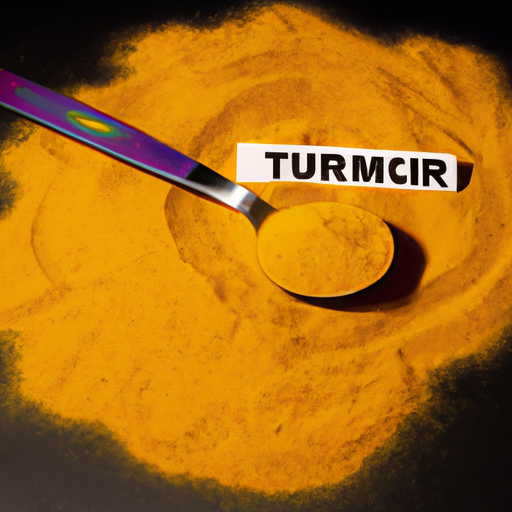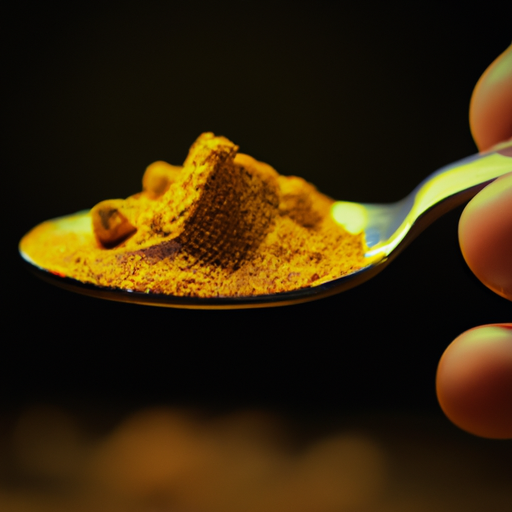As a person who values a healthy lifestyle, I am constantly searching for natural remedies that can enhance my overall well-being. One remedy that has piqued my interest is turmeric powder, renowned for its various health benefits.
But, when it comes to the active ingredient in turmeric powder, curcumin, how much is actually present in the powder? While it may not be the most exciting topic, understanding the amount of curcumin in turmeric powder is essential for anyone who wants to reap the health benefits of this spice.
Curcumin is the compound responsible for the bright yellow color of turmeric, as well as its anti-inflammatory and antioxidant properties. In this article, I will explore the factors that affect the concentration of curcumin in turmeric powder, the different types of turmeric powder available, and the methods used to measure curcumin content.
I will also provide tips on how to choose turmeric powder with high curcumin content and ways to increase your curcumin intake.
Key Takeaways
- Curcumin content in turmeric powder varies depending on extraction method, quality, region, and processing methods.
- On average, turmeric powder contains 2-5% curcumin by weight, but high-quality powders can contain up to 8%.
- Curcumin content can be measured using HPLC analysis and spectrophotometric analysis.
- To choose high curcumin content turmeric powder, read labels, and look for reputable brands.
The Health Benefits of Curcumin in Turmeric Powder
If you’re looking for a natural way to boost your health, you’ll be thrilled to know that turmeric powder contains a powerful compound called curcumin that offers a range of impressive benefits.
Curcumin supplementation has been shown to have anti-inflammatory properties, which can help alleviate symptoms of chronic inflammation, such as arthritis. It has also been linked to improved brain function and mental health, with some studies indicating that it may be effective in treating depression and anxiety.
In addition to its mental health benefits, curcumin has also been found to have positive effects on heart health, potentially reducing the risk of heart disease. It may also help lower cholesterol levels and improve blood vessel function.
With all of these benefits, it’s no wonder that curcumin is becoming an increasingly popular supplement. However, before you start taking supplements, it’s important to understand the curcumin content in turmeric powder.
Understanding Curcumin Content in Turmeric Powder
To gain a better understanding of the curcumin content in turmeric, you may want to explore the various factors that can impact its levels. One of the most important factors is the curcumin extraction method used. Some methods can extract more curcumin than others, resulting in higher levels of the compound in the turmeric powder.
Additionally, the absorption of curcumin in the body can also impact its efficacy. Studies have shown that curcumin is poorly absorbed by the body, and combining it with certain substances like black pepper can improve absorption.
Despite these factors, it’s important to note that the curcumin content in turmeric powder can vary widely depending on several other factors. These include the quality of the turmeric used, the region it was grown in, and the processing methods used.
Understanding these factors can help you make informed choices when selecting turmeric powder for its health benefits.
Factors that Affect Curcumin Concentration
You’ll be surprised to learn that several elements play a role in determining the potency of the golden spice, making it a challenging task to obtain the desired amount of the beneficial compound. Here are some factors that affect curcumin concentration in turmeric powder:
- Varietal differences: Curcumin content varies among different varieties of turmeric plants.
- Growing conditions: Soil quality, temperature, and other environmental factors affect the curcumin content.
- Harvesting and processing: The timing of harvest, drying, and processing methods can affect the curcumin content.
- Storage conditions: Exposure to light, air, and humidity can cause degradation of the curcumin content.
- Bioavailability: The amount of curcumin that’s absorbed and utilized by the body varies depending on factors such as the presence of other compounds in the turmeric powder and individual differences in metabolism.
Additionally, curcumin extraction methods can also influence the concentration of curcumin in turmeric powder. Some methods involve using solvents to extract curcumin, while others use water or other natural methods.
Understanding these factors can help you choose the right type of turmeric powder to meet your desired curcumin intake.
It’s important to note that the factors mentioned above can also affect the curcumin content in different types of turmeric powder. So, let’s take a closer look at the curcumin content in different types of turmeric powder.
Curcumin Content in Different Types of Turmeric Powder
Get ready to discover how the curcumin content varies in different types of turmeric! The levels of curcumin in turmeric powder can differ depending on the type. The three main types of turmeric are Alleppey, Madras, and Rajapuri, each with varying levels of curcumin content.
To better understand the differences in curcumin content, take a look at the table below. This table highlights the average curcumin content for each type of turmeric powder. Keep in mind that the absorption of curcumin can also vary depending on the method of consumption and the individual’s digestive system.
| Type of Turmeric | Curcumin Content |
|---|---|
| Alleppey | 3.14% |
| Madras | 2.50% |
| Rajapuri | 1.51% |
While Alleppey turmeric powder has the highest average curcumin content, it is important to note that this does not necessarily mean it is the most effective type for curcumin absorption. In the next section, we will explore the methods used to measure curcumin content and how they can impact its absorption.
Methods to Measure Curcumin Content
Imagine being able to accurately measure the amount of the potent compound found in turmeric that provides its numerous health benefits. There are several methods available to do just that!
One of the most commonly used methods is high performance liquid chromatography (HPLC) analysis. This method involves separating the curcumin compound from other components in the turmeric powder and then measuring its concentration. HPLC analysis is considered to be the most accurate method for measuring curcumin content in turmeric powder.
Another method that is often used to measure curcumin content is spectrophotometric analysis. This method involves measuring the absorption of light by the curcumin compound in the turmeric powder. The amount of light absorbed is directly proportional to the concentration of curcumin in the sample. While spectrophotometric analysis is less accurate than HPLC analysis, it is a simpler and more cost-effective method that can be used in many laboratories.
Now that we know about the methods used to measure curcumin content, let’s take a look at the average curcumin content in turmeric powder.
Average Curcumin Content in Turmeric Powder
Let’s take a look at how abundant the potent compound found in turmeric is, on average. Here are three interesting facts about the curcumin content in turmeric powder:
-
Turmeric cultivation plays a crucial role in determining the curcumin content. The variety of turmeric plant, the soil and climate conditions, and the maturity of the rhizomes all affect the amount of curcumin in the final product.
-
Curcumin extraction methods also impact the curcumin content in turmeric powder. Some methods, such as extraction with ethanol, yield higher amounts of curcumin than others, such as water extraction.
-
On average, turmeric powder contains around 2-5% curcumin by weight. However, some high-quality turmeric powders can contain up to 8% curcumin, which is considered to be a high amount.
Knowing these factors can help you choose a turmeric powder with high curcumin content. In the next section, I’ll discuss some tips on how to select the best turmeric powder for your needs.
How to Choose Turmeric Powder with High Curcumin Content
When choosing turmeric powder with high curcumin content, I always make sure to read the labels carefully. It’s important to look for brands that clearly state their curcumin content on the packaging.
I also prefer to buy from reputable brands that have a good track record of producing high-quality turmeric powder.
Reading Labels
To find out the amount of curcumin in turmeric powder, start by reading the labels carefully. Label interpretation is the key to determining the exact amount of curcumin in a particular turmeric powder brand. When examining the label, look for the curcumin percentage or the amount of curcumin per serving. Some brands may also list the total curcuminoids, which is the combined amount of all curcuminoids present in the turmeric powder.
Here’s an example of a table that can help in understanding the label:
| Brand | Curcumin Percentage | Curcumin Amount per Serving | Total Curcuminoids |
|---|---|---|---|
| Brand A | 3% | 50mg | 200mg |
| Brand B | 5% | 100mg | 250mg |
| Brand C | 2% | 40mg | 180mg |
| Brand D | 4% | 80mg | 220mg |
| Brand E | 1% | 20mg | 150mg |
It’s also important to consider ingredient sourcing when choosing turmeric powder. Some brands may use lower quality turmeric or add fillers to their product, which can affect the curcumin content. Look for brands that source their turmeric from high-quality, organic farms.
When buying turmeric powder, it’s important to choose from reputable brands that provide transparent labeling and use high-quality ingredients. By doing so, you can ensure that you are getting the highest amount of curcumin possible and are reaping all the potential health benefits of turmeric.
Buying from Reputable Brands
Choosing a reputable brand is essential for ensuring the highest quality and most beneficial turmeric product possible. When searching for a reputable brand, it’s important to look for companies that prioritize quality assurance. This means the company must use high-quality raw materials, employ effective manufacturing processes, and follow strict quality control standards.
Additionally, checking customer reviews can be helpful in determining the reliability and effectiveness of the brand’s products. When considering customer reviews, it’s important to look for feedback that specifically mentions the curcumin content of the turmeric product. Reputable brands should accurately label their products with the amount of curcumin per serving, and customers should be able to confirm this information through their reviews.
By choosing a reputable brand with high-quality products and positive customer reviews, consumers can ensure that they’re getting the most effective turmeric product possible for increasing their curcumin intake.
Transitioning into the subsequent section, there are other ways to increase curcumin intake beyond choosing a reputable brand.
Other Ways to Increase Curcumin Intake
One easy way to boost your intake of curcumin is by adding turmeric powder to your favorite recipes. Turmeric powder is a versatile spice that can be used in a variety of dishes, ranging from curries to smoothies. When cooking with turmeric, it’s important to keep in mind that curcumin is not very soluble in water, so it’s best to use some sort of fat or oil to help it absorb. Adding black pepper to your turmeric-containing dish can also help increase the bioavailability of curcumin.
If cooking with turmeric isn’t your thing, there are also supplement options available. However, it’s important to note that the bioavailability of curcumin supplements can vary greatly depending on the formulation and method of delivery. Some supplements use special technology to improve absorption, such as combining curcumin with phospholipids. It’s always a good idea to consult with a healthcare provider before starting any new supplements.
With these tips in mind, it’s easy to incorporate more curcumin into your diet and reap its potential health benefits.
When it comes to curcumin, it’s important to be aware of its potential side effects. While it’s generally considered safe in small doses, high doses may cause gastrointestinal issues such as nausea and diarrhea. Additionally, curcumin may interact with certain medications, such as blood thinners. It’s always a good idea to speak with a healthcare provider before taking any supplements or drastically increasing your intake of turmeric or curcumin-containing foods.
Potential Side Effects of Curcumin
Now that we’ve discussed ways to increase our curcumin intake, it’s important to note potential side effects associated with consuming too much curcumin. While curcumin is generally considered safe, it’s important to follow dosage recommendations to avoid adverse effects.
Possible risks associated with high doses of curcumin include gastrointestinal issues, such as nausea and diarrhea, and increased risk of bleeding. It’s also important to note that curcumin may interact with certain medications, such as blood thinners. Therefore, it shouldn’t be taken without consulting a healthcare professional.
To ensure safe consumption, it’s important to follow dosage recommendations and consult a healthcare professional before adding curcumin supplements to your diet.
Frequently Asked Questions
Can turmeric powder be used as a substitute for curcumin supplements?
Wow, I was blown away by how turmeric powder can be a great substitute for curcumin supplements! It’s a natural alternative that can boost your curcumin intake. Try incorporating it into your diet for a healthier lifestyle.
How long does it take for curcumin to start showing health benefits?
I’ve found that it can take anywhere from a few weeks to a few months for curcumin to start showing health benefits. The optimal dosage for these benefits varies based on individual needs and health status.
Is it safe to consume turmeric powder in large amounts to increase curcumin intake?
It is not safe to consume large amounts of turmeric powder to increase curcumin intake. Excessive intake may lead to gastrointestinal issues and interact with certain medications. Consult a healthcare provider for personalized advice on curcumin intake concerns.
Are there any foods or supplements that can enhance the absorption of curcumin?
Food combinations and bioavailability enhancers are key in maximizing curcumin absorption. Additionally, curcumin’s potential benefits for gut health should be considered. However, consuming large amounts of turmeric powder may have risks.
Can curcumin supplements interact with prescription medications?
I need to be cautious about taking curcumin supplements if I am on prescription medications. There is a risk of interactions, so it’s important to talk to my doctor about dosing recommendations.
Conclusion
So, how much curcumin is actually in turmeric powder? It all depends on various factors such as the type of turmeric, the region where it was grown, and the processing methods used.
However, studies have shown that turmeric powder typically contains between 2-5% curcumin by weight. While this may not seem like much, incorporating turmeric powder into your diet on a regular basis can provide numerous health benefits due to its anti-inflammatory and antioxidant properties.
So, next time you’re at the grocery store, make sure to check the label and choose a turmeric powder with a high curcumin content to reap the maximum benefits. And always remember, moderation is key and it’s important to consult with a healthcare professional before starting any new supplement regimen.










